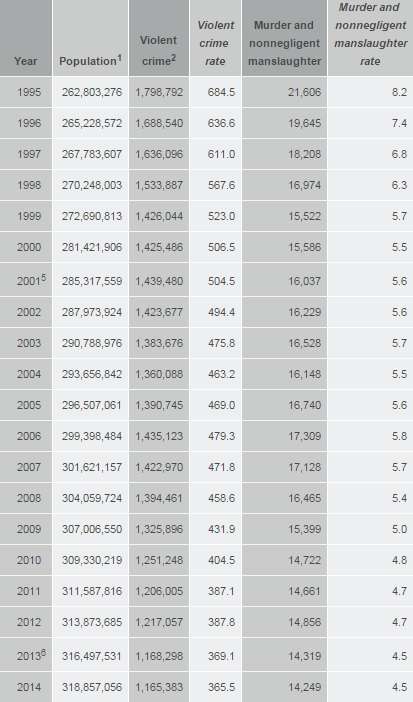Violent Crime and Murder Are Half What They Used to Be; Is That Changing?
Is San Bernardino the new normal or a non-representative event?

Earlier this fall, the FBI released crime statistics for 2014, the latest year for which data are fully available. In terms of violent crime generally and homicide specifically, those numbers are unambiguously good, with massive reductions in crime rates over the past 20 years.
In 1995, for instance, the violent crime rate (which includes murder, rape, robbery, and aggravated assault) per 100,000 inhabitants was 684.5. In 2014, it stood at 365.5. For murder and non-negligent manslaughter, the rate was 8.2 and 4.5 in 2014. These trends also show up in other violent crimes too.
In light of recent mass shootings in San Bernardino and Colorado, folks opposed to liberalized gun ownership and carry laws are quick to cry out that "enough is enough" and that, in the acerbic headline of the New York Daily News, "God isn't fixing this."
But the first thing we should be doing—especially before any meaningful information about either recent shooting has been released to the general public—is to establish whether in fact the United States is in fact seeing an increase in gun-related violence and crime.
As I noted earlier this morning, there's no reason to think so, despite a steady drip of headlines touting huge increases in homicide in large American cities. Writes Max Ehrenfreund in the Washington Post:
The total number of homicides in 2013 and 2014 in the 10 largest cities was 1,871 and 1,889 respectively. If current trends continue, there will be 2,178 homicides in those cities this year. That number would be less than the total for 2012 (2,224) and for any previous year since at least 1985 in those 10 cities.
"Crime and violence in most big cities in the United States are pretty much as they've been lately," said Franklin Zimring, a criminologist at the University of California, Berkeley. "Boy, is that good news."
The day after a horrific mass shooting is not a day to be crowing about "good news." But it's also not a day to speculate wildly about the causes of, much less the solutions to, events whose motives are far from clear. If the San Berdoo shooters were motivated by workplace animus (as some have speculated) and the Planned Parenthood shooter by ideology, would that change how we anticipate and avoid such events? What about nutjobs like Jared Loughner, the shooter of Gabby Giffords, whose mind is just a complete jumble (the same seems to go for Sandy Hook shooter Adam Lanza)? If we're serious about curbing mass shootings, all of this sort of stuff needs to be considered along with anything specifically related to gun ownership and possession. It may be that different types of shooters and locations require different defensive strategies.
But the very first thing we should be understanding is whether or not the problem of gun violence is increasing, declining, or holding steady. And what contributed to that trend.


Show Comments (30)